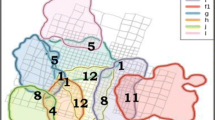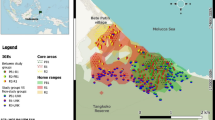Abstract
The nature of intergroup encounters differed between two populations of wild Japanese macaques (Macaca fuscata): the Yakushima and Kinkazan populations. In the Yakushima population, intergroup encounters were more likely to result in the displacement of one group, intergroup agonistic interaction was common, and intergroup dominance was usually distinct. When displacement occurred at Yakushima, larger groups tended to dominate smaller ones. Conversely, in the Kinkazan population, intergroup encounters rarely resulted in displacement, intergroup agonistic interaction was rare, and intergroup dominance was usually unclear. Thus, monkeys in Yakushima appear to defend resources actively during encounters, while those in Kinkazan usually did not defend resources. The frequency of encounters was significantly higher in Yakushima than in Kinkazan. The two populations had very different group densities and traveling speeds, both of which directly influence the chance of encounters. Taking these differences into account, we compared the observed frequency with those predicted by the ideal gas model. The observed frequencies in both populations were about one-third of the number expected with the model, which suggests that the differences in encounter frequency were caused by differences in group density and traveling speed. We discuss this intraspecific variation in light of economic defendability in connection to habitat differences and the evolutionary significance of resource defense behavior.
Similar content being viewed by others
REFERENCES
Agetsuma, N., and Nakagawa, N. (1998). Effects of habitat differences on feeding behaviors of Japanese monkeys: Comparison between Yakushima and Kinkazan. Primates 39: 275-289.
Anderson, C. M. (1981). Intertroop relations of chacma baboon (Papio ursinus). Int. J. Primatol. 2: 285-310.
Brown, J. D. (1964). The evolution of diversity in avian territorial systems. Wilson Bull. 76: 160-169.
Cheney, D. L. (1987). Interactions and relationships between groups. In Smuts, B., Cheney, D. L., Seyfarth, R. M., Wrangham, R. W., and Struhsaker, T. T. (eds.), Primate Societies, University of Chicago Press, Chicago, pp. 267-281.
Hamilton, W. J., Buskirk, R. E., and Buskirk, W. H. (1976). Defense of space and resources by chacma (Papio ursinus) baboon troops in an African desert and swamp. Ecology 57: 1246-1272.
Harding, R. S. O. (1976). Ranging patterns of troop of baboons (Papio anubis) in Kenya. Folia Primatol. 25: 143-185.
Harrison, M. J. (1983). Territorial behaviour in the green monkey, Cercopithecus sabaeus: Seasonal defense of local food supplies. Behav. Ecol. Sociobiol. 12: 85-94.
Holenweg, A. K., Noee, R., and Schabel, M. (1996). Waser's gas model applied to associations between red colobus and Diana monkeys in the Tai National Park, Ivory Coast. Folia Primatol. 67: 125-136.
Izawa, K. (1995). The ecological study of wild Japanese monkeys living in Kinkazan Island, Miyagi prefecture-On the population changes in recent three years [in Japanese with English summary]. Bull. Miyagi Univ. Educ. 30: 147-157.
Kawanaka, K. (1973). Intertroop relationships among Japanese monkeys. Primates 14: 113-159.
Kinzey, W. G., and Robinson, J. G. (1983). Intergroup loud calls, range size, and spacing in Callicebus torquatus. Am. J. Phys. Anthropol. 60: 545-553.
Klopfer, P. H., and Jolly, A. (1970). The stability of territorial boundaries in a lemur troop. Folia Primatol. 12: 199-208.
Maruhashi, T. (1982). An ecological study of troop fissions of Japanese monkeys (Macaca fuscata yakui) on Yakushima Island, Japan. Primates 23: 317-337.
Maruhashi, T., Saito, C., and Agetsuma, N. (1998). Home range structure and inter-group competition for land of Japanese macaques in evergreen and deciduous forests. Primates 39: 291-301.
Mitani, J. C., and Rodman, P. S. (1979). Territoriality: The relation of ranging pattern and home range size to defendability, with an analysis of territoriality among primate species. Behav. Ecol. Sociobiol. 5: 241-251.
Nishimura, A. (1990). A sociological and behavioral study of wooly monkeys, Lagothrix lagotrica, in the upper Amazon. Sci. Eng. Rev. Doshisha Univ. 31: 87-121.
Oates, J. F. (1977). The social life of a black-and-white Colobus monkey, Colobus guereza. Z. Tierpsychol. 45: 1-60.
Oates, J. F., and Trocco, T. F. (1983). Taxonomy and phylogeny of black-and-white colobus monkeys: Inferences from an analysis of loud call variation. Folia Primatol. 40: 83-113.
Papaj, D. R. (1994). Optimizing learning and its effect on evolutionary change in behavior. In Real, L. A. (ed.), Behavioral Mechanisms in Evolutionary Ecology, University of Chicago Press, Chicago, pp. 133-153.
Raemaekers, J. J., and Raemaekers, P. M. (1985). Field playback of loud calls to gibbons (Hylobates lar): Territorial, sex-specific and species-specific responses. Anim. Behav. 33: 481-493.
Robinson, J. G. (1979). Vocal regulation of use of space by groups of titi monkeys Callicebus moloch. Behav. Ecol. Sociobiol. 5: 1-15.
Saito, C., Sato, S., Suzuki, S., Sugiura, H., Agetsuma, N., Takahata, Y., Sasaki, C., Takahashi, H., Tanaka, T., and Yamagiwa, J. (1998). Aggressive intergroup encounters in two populations of Japanese macaques (Macaca fuscata). Primates 39: 303-312.
Sekulic, R. (1982a). Daily and seasonal patterns of roaring and spacing in four red howler Alouatta seniculus troops. Folia Primatol. 39: 22-48.
Sekulic, R. (1982b). The function of howling in red howler monkeys (Alouatta seniculus). Behaviour 81: 38-54.
Struhsaker, T. T. (1975). The Red Colobus Monkey, University of Chicago Press, Chicago.
Takasaki, H. (1981). Troop size, habitat quality, and home range area in Japanese macaques. Behav. Ecol. Sociobiol. 9: 227-281.
Tenaza, R. R. (1975). Territory and monogamy among Kloss' gibbons (Hylobates klossii) in Siberut Island, Indonesia. Folia Primatol. 24: 60-80.
Thomsen, R. (1996). A comparison of the habitat quality of two troops of Japanese Macaques (Macaca fuscata yakui) on Yakushima Island and their ecological strategies, Master's thesis, Department of Physical Geography, LM-University of Munich, Germany [in German].
Tilson, R. L. (1981). Family formation strategies of Kloss's gibbons. Folia Primatol. 35: 259-287.
Van Schaik, C. P., Assink, P. R., and Salafsky, N. (1992). Territorial behavior in Southeast Asian langurs: Resource defense or mate defense? Am. J. Primatol. 26: 233-242.
Vessey, S. H. (1968). Interactions between free-ranging groups of rhesus monkeys. Folia Primatol. 8: 1968.
Waser, P. M. (1975). Experimental playbacks show vocal mediation of intergroup avoidance in a forest monkey. Nature 255: 56-58.
Waser, P. M. (1976). Cercocebus albigena: Site attachment, avoidance, and intergroup spacing. Am. Nat. 110: 911-935.
Waser, P. M. (1982a). The evolution of male loud calls among mongabeys and baboons. In Snowdon, C. T., Brown, C. H., and Petersen, M. (eds.), Primate Communication, Cambridge University Press, New York, pp. 117-143.
Waser, P. M. (1982b). Primate polyspecific associations: Do they occur by chance? Anim. Behav. 30: 1-8.
Waser, P. M. (1984). ''Chance'' and mixed-species associations. Behav. Ecol. Sociobiol. 15: 197-202.
Waser, P. M., and Wiley, R. H. (1979). Mechanisms and evolution of spacing behavior. In Marler, P., and Vandenbergh, J. G. (eds.), Handbook of Behavioral Neurobiology Vol. 3, Social Behavior and Communication, Plenum Press, New York, pp. 159-223.
Whitesides, G. H. (1989). Interspecific associations of Diana monkeys, Cercopithecus diana, in Sierra Leone, West Africa: Biological significance or chance? Anim.Behav. 37: 760-776.
Yamagiwa, J., Izawa, K., and Maruhashi, T. (1998). Long-term studies on wild Japanese macaques in natural habitats at Kinkazan and Yakushima: Preface. Primates 39: 255-256.
Yoshihiro, S., Furuichi, T., Manda, M., Ohkubo, N., Kinoshita, M., Agetsuma, N., Azuma, S., Matsubara, H., Sugiura, H., Hill, D., Kido, E., Kubo, R., Matsushima, K., Nakajima, K., Maruhashi, T., Oi, T., Sprague, D., Tanaka, T., Tsukahara, T., and Takahata, Y. (1998). The distribution of wild Yakushima macaque (Macaca fuscata yakui) troops around the coast of Yakushima Island, Japan. Primate Res. 14: 339-349.
Yoshihiro, S., Ohtake, M., Matsubara, H., Zamma, K., Han'ya, G., Tanimura, Y., Kubota, H., Kubo, R., Arakane, T., Hirata, T., Furukawa, M., Sato, A., and Takahata, Y. (1999). Vertical distribution of wild Yakushima macaques (Macaca fuscata yakui) in the western area of Yakushima Island, Japan: Preliminary report. Primates 40: 409-415.
Author information
Authors and Affiliations
Rights and permissions
About this article
Cite this article
Sugiura, H., Saito, C., Sato, S. et al. Variation in Intergroup Encounters in Two Populations of Japanese Macaques. International Journal of Primatology 21, 519–535 (2000). https://doi.org/10.1023/A:1005448120967
Issue Date:
DOI: https://doi.org/10.1023/A:1005448120967




